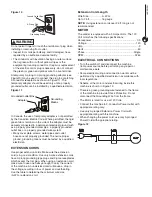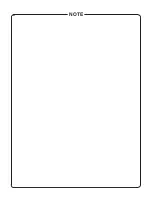
7
TROUBLESHOOTING
TROUBLESHOOTING
SYMPTOM
POSSIBLE CAUSE(S)
CORRECTIVE ACTION
Sanding Grains
easily rub off belt.
1. Sanding belt has been stored in
an incorrect environment.
2. Sanding belt has been
damaged or folded.
1. Ensure sanding accessories are stored away
from extremely hot or dry temperatures.
2. Store sanding accessories flat – not bent or
folded.
Deep sanding
grooves or scars
in workpiece.
1. Sanding belt grit is too coarse
for the desired finish.
2. Workpiece sanded across the grain.
3. Too much sanding force on the
workpiece.
4. Workpiece held still against the belt
for too long.
1. Use a finer-grit sanding accessory.
2. Sand with the grain of the wood.
3. Reduce pressure on workpiece while sanding.
4. Keep workpiece moving while sanding on the
sanding accessory.
Sanding surface
clogs quickly.
1. Too much pressure against belt/
disc.
2. Sanding softwood.
1. Reduce pressure on workpiece while sanding.
2. Use different stock, different sanding
accessories, or accept that this will happen
and plan on cleaning or replacing discs/belts
frequently.
Burns on
workpiece.
1. Using a sanding grit that is too fine.
2. Using too much pressure.
3. Work held still for too long.
1. Use a coarser-grit sanding accessory.
2. Reduce pressure on workpiece while sanding.
3. Do not keep workpiece in one place for too
long.
Motor will not
start –
fuses or circuit
breakers tripping
or blowing.
1. Short circuit in line, cord or plug.
2. Short circuit in motor or loose
connections.
3. Incorrect fuses or circuit breakers in
power line.
1. Inspect cord or plug for damaged insulation
and shorted wires.
2. Inspect all connections on motor for loose or
shorted terminals and/or worn insulation.
3. Install correct fuses or circuit breakers or
switch tool to an appropriately size circuit.
Motor overheats.
1. Motor overloaded.
2. Extension cord too long and of
insufficient gauge (weight).
1. Reduce load on motor (pressure on object
being sanded).
2. Utilize an extension cord of appropriate gauge
and length or plug tool directly into outlet.
Motor stalls
(resulting in blown
fuses or tripped
circuit).
1. Short circuit in motor or loose
connections.
2. Low voltage.
3. Incorrect fuses or circuit breakers in
power line.
4. Motor overload.
1. Inspect connections on motor for loose or
shorted terminals or worn insulations.
2. Correct low voltage conditions (for example:
improper extension cord length and/or gauge).
3. Install CORRECT fuses or circuit breakers or
plug tool into an appropriate circuit, matched to
an appropriate fuse or breaker.
4. Reduce the load on the motor.
Machine slows
when
operating.
1. Feed rate too great.
2. Undersized circuit or use of
undersized extension cord.
1. Reduce the rate at which the workpiece is fed
into the working area of the tool.
2. Ensure circuit wires or extension cords are
proper gauge, or eliminate use of extension
cords.
Machine vibrates
excessively.
1. Rubber feet worn, mounting
hardware loose
2. Workbench or table is not level
3. Worn bearings
1. Replace the rubber feet, tighten mounting
hardware
2. Shim or adjust as need
3. Have bearings replaced by service
technician.
Workpiece
frequently
gets pulled out of
operator’s hands.
1. Not supporting the workpiece
against the stop.
2. Attempting to sand (unaided) a
workpiece that is too small.
1. Use the platen (backstop) to support the
workpiece.
2. Use another hand tool or jig to grasp or hold
the workpiece.
7
Содержание BD1030
Страница 10: ...1 x 30 BELT SANDER PARTS ILLUSTRATION 8 PARTS LIST 8 ...
Страница 13: ...NOTE ...
Страница 14: ...NOTE ...
Страница 15: ...NOTE ...
Страница 16: ...Southern Technologies LLC 3816 Hawthron CT Waukegan IL 60087 ...


































